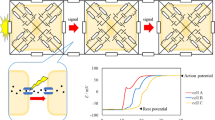Abstract
The effects of osmotic pressure on inward sodium current during a change in temperature were investigated during experiments on isolated rat spinal ganglia neurons using techniques of intracellular perfusion and voltage clamping. It was found that the effect of osmotic pressure on the kinetic parameters of sodium current does not depend on temperature over a wide range of 8–40°C; the apparent values of activation energies for the activation and inactivation processes do not dependent on degree of osmolality. Overall findings would appear to indicate that the osmotic pressure effect is actually initiated by association with aqueous transmembrane flux. Opinions are expressed as to the location of the structures through which this aqueous flux passes and of the sodium channel gating mechanism, together which the molecular mechanisms of interaction between these two elements.
Similar content being viewed by others
Literature cited
A. Kotyk and K. M. Janacek, Biomembranes: An Interdisciplinary Approach, Plenum Press (1977).
O. A. Kryshtal' and V. I. Pidoplichko, “Intracellular perfusion of the snail giant neuron,” Neirofiziologiya,7, No. 3, 327–329 (1975).
O. A. Kryshtal', Yu. V. Osipchuk, and V. I. Pidoplichko, “Kinetics of sodium inward current in perfused neurons is governed by the transmembrane gradient of osmotic pressure,” Dokl. Akad. Nauk SSSR,259, No. 5, 1253–1256 (1981).
Yu. V. Osipchuk, “Modification of osmotic pressure gradient of the inward sodium current channel gating mechanism at the membrane of the perfused neuron,” Neirofiziologiya,15, No. 4, 437–439 (1983).
Z. A. Sorokina, I. V. Chizhmakov, G. B. Elyakov, et al., Investigating mechanisms of inactivation of fast sodium channels using neurotoxin fromRadiantus macrodactylis actinium and different chemical reagents,” Fiziol. Zh.,30, No. 5, 571–579 (1984).
B. I. Khodorov, “Steroid alkaloid batrachotoxin for use in research into voltage-dependent sodium channels,” Neirofiziologiya,17, No. 3, 409–422 (1985).
D. R. Evans, S. G. Warren, B. P. F. Edwards, et al., “Aqueous central cavity in aspartate transcarbamylase fromEscherichia coli,” Science,179, No. 4074, 683–685 (1973).
J. Ferrier, “Osmosis and intermolecular force,” J. Theor. Biol.,106, No. 4, 449–453 (1984).
J. E. Kimura and H. Meves, “The effect of temperature on the asymmetrical charge movement in squid giant axons,” J. Physiol.,289, No. 3, 479–500 (1979).
O. A. Krishtal, Ju. V. Osipchuk, and V. I. Pidoplichko, “The transmembrane gradient of osmotic pressure modifies the kinetics of sodium currents in perfused neurons,” Experientia,39, No. 5, 194–195 (1983).
R. I. Macey, “Transport of water and urea in red blood cells,” Am. J. Physiol.,246, No. 3, Pt. 1, 195–203 (1984).
K. P. Repke, “Structural basis of the compartmentalization functions of biomembranes,” in: Cell Compartmentalization and Metabolic Channeling, L. Nover, F. Lynen, and K. Mothes, eds., VEB Gustav Fischer Verlag, Jena, and Elsevier, Amsterdam (1980), pp. 33–46.
Additional information
A. A. Bogomolets Institute of Physiology, Academy of Sciences of the Ukrainian SSR, Kiev. Translated from Neirofiziologiya, Vol. 18, No. 4, pp. 518–525, July–August, 1986.
Rights and permissions
About this article
Cite this article
Chizhmakov, I.V., Sorokina, Z.A. Non-temperature related effects of osmotic pressure on inward sodium current in the membrane of isolated rat spinal ganglia neurons. Neurophysiology 18, 380–385 (1986). https://doi.org/10.1007/BF01052808
Received:
Issue Date:
DOI: https://doi.org/10.1007/BF01052808




